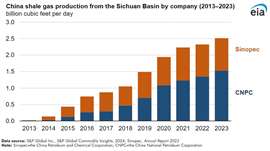China’s unconventional gas push
30 September 2024
Country seeks ways to limit import dependence

China has been seeking ways to reduce import dependence on natural gas, according to the U.S. Energy Information Administration (EIA).
China, which is a major natural gas importer by pipeline and the world’s largest importer of liquefied natural gas (LNG), produced natural gas from shale in the Low Cambrian formation in the Sichuan Basin at a depth exceeding 14,760 feet, marking the first time that commercially viable natural gas was produced from this deeper formation.
According to a report from S&P Global Commodity Insights (SPGCI), the China National Petroleum Corporation (CNPC) in 2023 produced natural gas SPGCI reported that the Zi 201 well initially produced 26.1 million cubic feet per day (MMcf/d), a commercial rate that could signify the entry of the Cambrian formation into a new phase of large-scale shale gas development, the EIA stated.
“Currently, only two of China’s national oil companies—CNPC and the China Petroleum and Chemical Corporation (Sinopec)—produce shale gas, mainly from the existing fields in the Silurian Longmaxi formation of the Sichuan Basin,” the EIA reported. “At an average depth of 11,500 feet, the Silurian Longmaxi shale formation is shallower than the Low Cambrian.”
China’s domestic shale gas production averaged 2.51 billion cubic feet per day (Bcf/d) in 2023, up from 0.02 Bcf/d in 2013, according to data compiled by SPGCI. Since 2013, Chinese companies have gained a greater geological understanding of shale formations and deployed more advanced hydraulic and automation techniques, steadily growing shale gas production.
“However, we estimate that shale gas accounted for just 12% of China’s domestic natural gas production of 21.7 Bcf/d in 2023 as geological and cost issues have hampered more rapid development,” the EIA stated. “ In 2023, China’s natural gas imports averaged 16.0 Bcf/d and accounted for 42% of China’s total natural gas supply, compared with 15% of its supply in 2010.”
In 2018, the Chinese Ministry of Finance and the State Administration of Taxation introduced a preferential tax policy to reduce the resource tax on shale gas production to 4.2% from 6.0%. Last year, this policy was extended through December 2027.
Following the release of China’s 14th Five-Year Plan in 2021, policy directives continued to support development of unconventional natural gas resources. Production from unconventional formations, such as tight gas, shale gas, and coal-bed methane in China averaged 8.6 Bcf/d in 2023.
Currently, China is one of four countries in the world where commercial volumes of shale gas are being produced. The others are the United States, Canada, and Argentina.
MAGAZINE
NEWSLETTER
CONNECT WITH THE TEAM









